Abstract
A 1:25 scale physical model test was employed to study the plane gate vibration and holding force under the conditions of the fixed gate opening and closing process, respectively. We paid more attention to the characteristics of the gate vibration, holding force and the failure of gate-closing in closing process. The correlation between gate vibration and holding force was further examined. The results show that vertical vibration is weaker than the lateral and horizontal vibrations in fixed gate opening and is stronger than the lateral and vertical vibrations in closing process. Gate vertical vibration is self-excited vibration with a frequency of 7–14 Hz. Besides, crawl vibration in closing process is related to the upstream water depth. The higher the water level is, the earlier the crawl vibration appears. After the crawl stage, plane gate stops motion at a certain distance from the chamber floor and then the failure of gate-closing happens. Finally, gate vibration in three directions is significantly correlated with the holding force. In closing process, holding force has positive correlation with the vertical vibration and has negative correlation with the lateral and horizontal vibrations. In the crawl stage, the average of correlation coefficient in lateral, vertical and horizontal direction is −0.723, 0.733 and −0.664, respectively. Thus, the influence of gate vibration on holding force should be taken into consideration in determining the hoists capacity.
1. Introduction
Vibration problems in water conservancy projects (including dams, gates and plants) caused by spillway is a common phenomenon. It can cause serious consequences and threaten the safe and stable operation of water conservancy projects [1,2,3,4]. Flow-induced vibration of plane gate is an important subject in water conservancy engineering. Its vibration mechanism and vibration control method are both the focus of research.
There are many excellent opinions in the literature dealing with the basic mechanism of flow-induced vibration of gate. Hardwick [5] and Jongeling [6], through the experiment, pointed out that the main cause of gate vibration was vortex formed by the failure of free shear layer at the bottom edge of gate. Based on the mechanism of flow-induced vibration, Naudascher [7] divided the gate vibration into three categories: (1) gate vibration induced by the instability of water flow; (2) gate vibration induced by flow instability and structure feedback mechanism; and (3) gate vibration caused by the induced force generated by structure motion. Thang [8,9] believed that gate vibration was caused by the downstream vortex resonance. Ishii et al. [10,11] supposed that fluid feedback force induced by gate vibration mainly included two aspects: pressure pulsation caused by the alternating flow and alternating excitation generated by the vortex at the gate bottom edge. Kunihiro et al. [12] considered that the vibration of radial gate with small opening was nonlinear self-excited vibration. In addition, Mostafiz et al. [13] and Keiko et al. [14] conducted studies on gate vibration from the perspective of frictional damping and gate opening-closing process in the physical model test. Kolkman et al. [15] expounded the fluid inertia mode of the gate vertical vibration and believed that, in self-excited vibration process, variation of the effective flow area led to the flow pulsation and fluid inertia may aggravate the gate vibration.
When gate vibrates by the hydrodynamic loads under the high-speed flow, flow field around the gate alters acutely and the structure dynamic loads change in turn, which forms the fluid–solid coupling effect. Most vibration control methods are to change the shape of the gate bottom edge, which could realize the stability of the flow pattern and weaken the vibration magnitude. For example, Markovic et al. [16] came up with a measure to effectively reduce hydrodynamic loads through placing penetrating orifice at the gate bottom beam. Erdbrink et al. [17] arranged some ventilation slots at the plane gate bottom and water could flow into the upstream panel and out at the gate bottom edge, which destroyed the reattachment effect between flow and gate bottom edge, smoothed the outflow state and effectively mitigate the vertical vibration. Seung et al. [18] proposed a method that can effectively reduce the gate vibration magnitude and abate the gate fatigue damage by setting a guide plate at gate bottom edge. Demirel et al. [19] mounted the horizontal porous baffle at elevation below the free surface to reduce the vortex magnitude in the downstream and enhance the stability of plane gate.
Due to the increasing demand for hydroelectric energy, construction of high-head water conservancy projects put forward a high requirement for the safe operation of gate. Much work so far has focused on the static load monitoring, vibration displacement, structural stress and so on. These achievements were largely obtained by fixed gate opening, and the flow under the gate can be viewed as a steady flow [20,21,22,23]. However, little attention has been devoted to the gate vibration and its effect on the holding force in closing process. When gate is in continuously closing process, fluid boundary deforms in a large scale and the flow passing the gate becomes markedly unsteady process. To determine the characteristics of gate vibration and holding force in closing process, we simultaneously measured the gate acceleration and holding force through the physical model test and then examined the correlation between the two variables. Further studies on the characteristics of vortex shedding in closing process and the method for evaluating the gate vibration effect on the holding force will be summarized in our subsequent study.
This paper is divided into four parts. Section 1 briefly describes the achievements about gate vibration and its control methods. Section 2 introduces the arrangement of physical model test and measuring point installation. Section 3 mainly discusses the characteristics of gate vibration and holding force and examines the correlation between gate vibration and holding force under two operation modes. The conclusion is given in Section 4.
2. Physical Model Test
The physical model test made of transparent Perspex plastic, at the scale 1:25, was established based on the gravity similarity criterion and flow similarity criterion. The parameters of the steel plane gate in the actual project are shown in Table 1. The physical model test was composed of five parts: tank, chamber, narrow-section, pressure hole and drainage channel (Figure 1). Two plane gates with same size were made of Perspex plastic and hydro-elastic material, respectively. Meanwhile, the hydro-elastic gate model should satisfy the structural similarity criterion to ensure the normal similitude of gate stiffness [24]. The mass and elastic modulus of hydro-elastic gate is 7.36 kg and 8 GPa, respectively.

Table 1.
Parameters of the prototype gate.
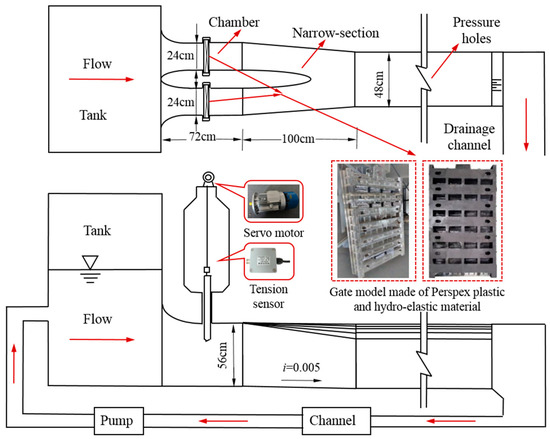
Figure 1.
Schematic diagram of experiment setup.
In the physical model test, the plane gate was connected to the servo motor by steel cable and gate operation speed was 0.005 m/s. The tension sensor with a range of 100 kg was placed to measure the holding force. Three acceleration sensors were installed near the gate lug with lateral direction (gate width direction), vertical direction (gate height direction) and horizontal direction (flow direction), successively. Pulsating pressure sensors were arranged on the gate panel and bottom edge. Meanwhile, in the case of fixed gate opening the recording of data lasted for 60 s. In the case of closing process data acquisition lasted for the duration of the operation. Data Acquisition & Signal Processing (DASP) intelligent acquisition system developed by China Orient Institute of Noise & Vibration was employed to acquire and process the data cooperated with constant current power supplier. It can simultaneously measure the gate vibration acceleration and holding force at the sampling frequency of 200 Hz [25]. Data measuring, transmission and processing are depicted in Figure 2. Besides, in the physical model test, there are two operation modes of the gate, namely fixed gate opening and closing process. Gate opening ratio e in fixed gate opening equals gate opening height dividing the height of spillway tunnel. The upstream water depths were 0.64, 0.72, 0.8 and 0.92 m in the physical model test, successively (prototype depths were 16, 18, 20 and 23 m, respectively). Downstream outflow condition is free outflow. Rectangular weir was arranged in front of the drainage channel to measure the flow rate. The water levels on the tank and the rectangular weir were measured through water level meters. In addition, in closing process, we obtained the relationship acceleration or holding force with time from the experiment. To get the vibration or holding force at a certain gate opening in closing process, we firstly assume that gate opening is linear with the time. Subsequently, the vibration or holding force is approximately equal to the results of a specific time interval in closing process. In this paper, the specific time is linear with a certain gate opening and the interval is set to 1 s with 200 data.
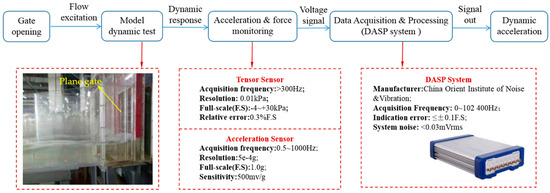
Figure 2.
Dynamic testing system applied in the physical model test.
3. Results and Discussion
3.1. Characteristics of Vibration
Characteristics of plane gate vibration are related to the constraint boundaries and external excitations. Constraint boundaries of plane gate mainly include steel cable connected to the hoists, friction contact between the slide block and track, and friction contact between the rubber seal and sidewall. Once the constraint condition is determined, gate vibration is related to the external excitations. Thus, it is necessary to clarify the relationship between gate vibration with gate opening and upstream water depth. In previous investigations, plane gate was regarded as a rigid body, and its vertical vibration can be equivalent to a single degree of freedom [26,27]. Elastic deformation of steel cable is the main manifestation of the structural stiffness. Given the generalized stiffness theory, the equivalent stiffness of steel cable equals the generalized force dividing generalized displacement. When steel cable has the axial force P, axial deformation Δ can be expressed
The equivalent stiffness of the steel cable K is, that is the gate vertical equivalent stiffness,
Thus, nature frequency of simplified system ωn can be expressed
where E is the elastic modulus of steel cable; A is the sectional area of the steel cable; L is the steel cable length; and m is simplified system mass.
On basis of the equivalent stiffness theory, gate vertical equivalent stiffness K is related to the steel cable length L and simplified system mass m. Through the physical model test, we mainly analyzed and compared the characteristics of gate vibration under the two operation modes.
3.1.1. Vibration in Fixed Gate Opening
Because the acceleration spectrums are similar under different water depth conditions, Figure 3 only depicts the acceleration spectrums under three directions for the upstream water depth of 20 m. As revealed in Figure 3, the acceleration in three directions decreases gradually with the gate opening decrease, which is consistent with the prototype observation by Yan et al. [28]. Yan et al. pointed out that flow pulsation pressure decreased with gate opening decrease and root mean squire (RMS) of pulsation pressure can reach 10% of the upstream total head in large gate opening. However, Yang et al. [29], with Particle Image Velocimetry (PIV) technology through the physical model test, stated that, the smaller is the gate opening and the greater is the flow rate, the greater is the gate vibration. It was confused that gate vibration unexpectedly emerged different results at the same gate opening. The gate operation condition might account for the difference. In this physical model test and prototype observation from [28], the flow passing the gate is free outflow and not restricted by the downstream water depth. Nevertheless, gate vibration has been influenced by the downstream water depth in the physical model test in [29]. This means that different outflow conditions could produce different results. Thus, outflow condition is also an effect factor of gate vibration.
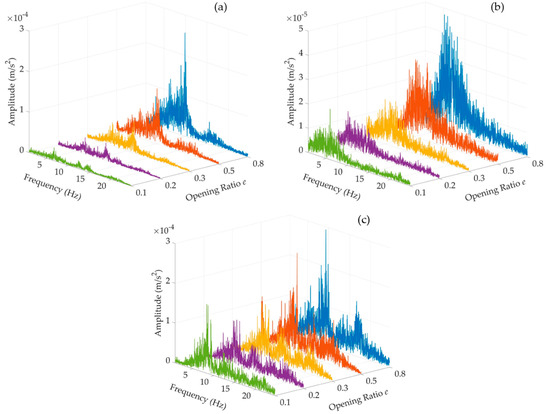
Figure 3.
Acceleration spectrums in three directions for upstream water depth of 20 m: (a) lateral direction; (b) vertical direction; and (c) horizontal direction.
Furthermore, the dominant frequency of vibration in three directions was also obtained from the results in Figure 3. In lateral direction, the dominant frequency is mainly concentrated around 8 Hz. As gate opening decreases, the frequency is not prominent and vibration energy is dispersed gradually. Then, in vertical direction, the dominant frequency gradually decreases with gate opening decrease and is distributed up to 10 Hz. Vibration energy is relatively concentrated with a peak value and there is no energy dispersion. In horizontal direction the dominant frequency with multiple peaks under each gate opening has no obvious change. The frequency is mainly distributed below 20 Hz and frequency bandwidth is relatively wide. Besides, comparing the vibration spectrums at different water depths, we found upstream water depth could markedly change the acceleration magnitude and have a little influence on the dominant frequency yet. Meanwhile, flow pulsation frequency near the gate bottom edge is relatively small. The dominant frequency is 0.13–0.2 Hz. Because vibration frequency is far away from the flow pulsation frequency, the plane gate does not resonate with the flow and is self-excited vibration in fixed gate opening.
3.1.2. Vibration in Closing Process
In closing process, this paper pays more attention to the gate vertical vibration. Figure 4 provides the vertical acceleration in closing process and its partial magnification diagram. Considering the characteristics of the vertical vibration, the gate vibration process can be divided into three stages: initial stage, transitional stage and crawl stage. In the initial stage, vibration acceleration is relatively small, and its regularity is insignificant. In the transitional stage, vibration acceleration increases gradually and gate continues to fall without intermittent motion. Subsequently, in the crawl stage, vibration acceleration increases continuously and gate drops down intermittently.
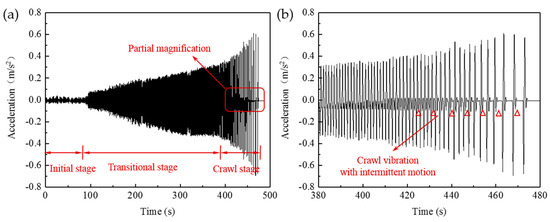
Figure 4.
Vertical acceleration with gate-closing time: (a) vertical acceleration in closing process; and (b) partial magnification of vertical acceleration.
Figure 5a shows the amplitude of vertical acceleration in closing process. The amplitude is different for different stages. In the initial stage, the amplitude varies slightly and maintains at 0.01 m/s2. Afterwards, the amplitude increases gradually. The higher the upstream water depth, the greater the amplitude. The maximum amplitude can reach 0.11 m/s2 approximately in the crawl stage and is almost 10 times higher than the initial stage. Moreover, Figure 5b plots the dominant frequency of the vertical vibration in closing process. For different upstream water depths, frequency distribution is relatively stable, and its regularity is remarkable after the initial stage. In this period, the dominant frequency gradually decreases from 14 to 7 Hz in the form of steps. As upstream water depth increases, the step moves into the origin of the coordinate and the frequency decreases gradually. This means gate vibration is directly related to the upstream water depth. Due to the dominant frequency far away from the flow pulsation frequency, we regard that gate vertical vibration is self-excited vibration in closing process.
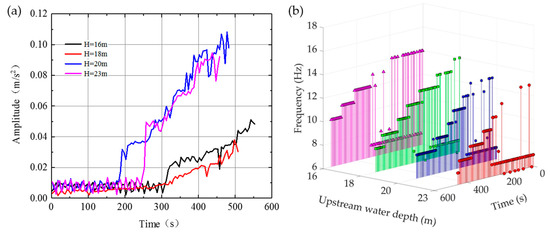
Figure 5.
Characteristics of the vertical vibration in closing process: (a) amplitude of acceleration; and (b) dominant frequency of acceleration.
In addition, Figure 6 reveals the amplitude of acceleration in lateral and horizontal direction. The characteristics of lateral vibration is the same as that of vertical vibration. Nevertheless, the vibration magnitude is relatively small, and the maximum of amplitude can reach 0.013 m/s2. In horizontal direction, the amplitude changes a little with time and mostly maintains below 0.008 m/s2. However, unusual fluctuation peaks of acceleration appeared near 130 s, as depicted in Figure 6a. The main reason for the situation lies in the defect of the model itself. Because the physical model was built in summer and fixed by steel structure, the guide track deformed slightly at a lower temperature. The defective area is located in large gate opening. Gate opening ratio e is roughly 0.83 and it is not the focus area of the study. Moreover, this defect does not significantly influence the vertical vibration results for a small gate opening, as described in Figure 5a. Therefore, we can ignore this defect in the following research.
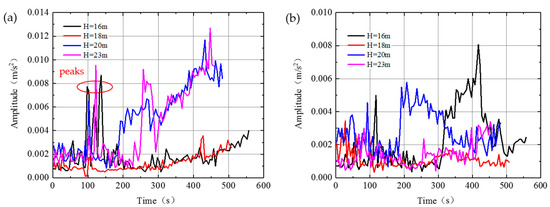
Figure 6.
Characteristics of acceleration amplitude in closing process: (a) lateral direction; and (b) horizontal direction.
3.1.3. Comparison of Vibration in Two Operation Modes
The above describes the characteristics of gate vibration in fixed gate opening and closing process, respectively. This section mainly compares gate vibration for two operation modes. When gate is in fixed gate opening, the acceleration in the three directions decreases gradually with gate opening decrease. The lateral and horizontal vibrations are larger than the vertical vibration. However, in closing process, acceleration increases gradually with gate opening decrease, which is contrary to the fixed gate opening. Besides, vertical acceleration is the largest, followed by the lateral direction and horizontal direction is the smallest. From the perspective of the frequency, vibration frequency is mainly related to the gate opening and is independent of the upstream water depth in fixed gate opening. Frequency in each direction is markedly different. Nevertheless, in closing process, upstream water depth and gate opening both impact the vibration frequency. As the upstream water depth increases and gate opening decreases, vertical vibration frequency reduces gradually. The above differences are mainly caused by two aspects: the gate motion state and unsteady flow. Firstly, the gate motion state influences the boundary conditions and nature frequency of simplified system. Secondly, unsteady flow arising from gate-closing process significantly changes the hydrodynamic loads acting on the gate body. These two effects motivate a strong fluid–solid coupling in closing process, and it is markedly different from that of fixed gate opening.
3.2. Characteristics of Holding Force
Gate holding force directly determines the hoists capacity and is of great significance to the stable and safe operation of gate. Many accidents are related to the holding force in practical engineering. To determine the hoists capacity, hydrodynamics loads is a vital influential factor, in addition to the mechanical factors. Although the influence of hydrodynamics loads on hoists capacity has been explained in the relevant criterion [30], the criterion does not seem to meet the practical requirements on condition of the complex gate structure, operation conditions and design scale at present. It is necessary to clarify the hydrodynamics loads in closing process. The holding force can be expressed:
where n is modified coefficient of gate weight, Ggate is gate self-weight, Gj is additional weight, Ws is water column weight on the gate top, Ff is friction force and PX − Pt is vertical hydrodynamic force at the gate bottom edge.
3.2.1. Holding Force in Two Operation Modes
From Equation (4), many factors can influence the holding force. In fixed gate opening, water column on the gate top and panel thrust have a relatively clear theoretical relationship with gate opening and upstream water depth. Thus, the characteristics of holding force mainly represent the characteristics of the pressure at gate bottom edge.
Table 2 summarizes the holding force and its standard deviation in fixed gate opening. As upstream water depth increases, holding force generally decreases. In large gate opening, however, the holding force increases slightly with the upstream water depth increase because gate lattice is partly filled with water. The higher is the water level, the more water there is in the gate lattice and the greater is the holding force. In small gate opening, gate lattice is fully filled with water for different operation conditions. The influence of water in the gate lattice is insignificant for the holding force.

Table 2.
Holding force and its standard deviation in fixed gate opening.
In addition, standard deviation gradually decreases with the gate opening decrease for a certain upstream water depth, as shown in Table 2. Standard deviation is proportional to water depth in large gate opening. In small gate opening, it is inversely proportional to water depth. It indicates that upstream water depth impacts the pressure at gate bottom edge and the influence is nonlinear. Therefore, the suggestion that the pressure specified as 20 kN/m or a linear formula in the criterion does not seem to satisfy the practical requirements and need to further investigate [30].
For different upstream water depths, dominant frequency of holding force in each opening is 0.033–0.217 Hz. The frequency is not equal or close to the vertical vibration frequency and is not close to the flow pulsation frequency yet.
Subsequently, Figure 7 plots the holding force for different conditions in closing process. As upstream water depth rises, the gate-closing time decreases gradually when gate stops moving. In the initial stage, holding force varies slightly and the maximum holding force occurs near 100 s. It indicates that vertical hydrodynamic loads varies significantly and can markedly change the holding force. In the transitional crawl stage, holding force decreases gradually in a reciprocation form. It is consistent with the existing research [31]. Liang et al. [31] reckoned that holding force is a process of elastic energy stored by the steel cable releasing and storing. Specifically, the elastic energy of steel cable goes through a cycle of release–reserve–re-release–re-reserve in closing process. Afterwards, the friction forces by the loads acting on the gate body gradually increase, make the holding force gradually decrease and prevent the gate from dropping down.
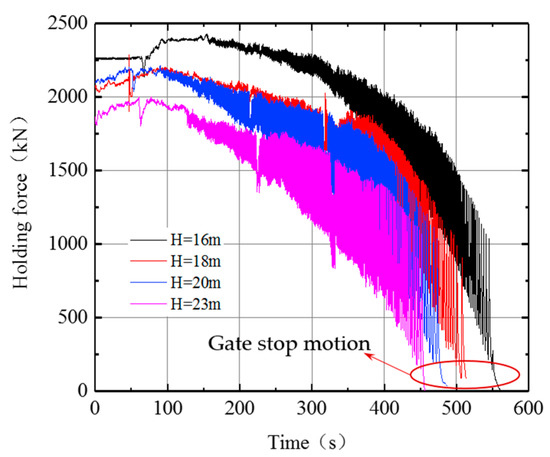
Figure 7.
Holding force for different conditions in closing process.
Figure 8a shows the fluctuation value of holding force in closing process. In the initial stage, the fluctuation value is small. As gate continues to go down, the fluctuation value suddenly increases rapidly. The higher is the upstream water level, the greater is the fluctuation value. Besides, Figure 8b depicts the dominant frequency of holding force. Frequency distribution is regular and its value reduces from 14 to 7 Hz in a step form. In addition, without considering the elastic hysteresis of the steel cable, axial deformation of steel cable obtained through the Equation (1) should equal the gate vertical vibration displacement. Meanwhile, we noticed that the dominant frequency of holding force is consistent with the gate vertical vibration frequency in closing process, which indicates that it is reasonable to analyze the vertical vibration through the holding force. It can be further manifested that it is feasible, in a study of gate vertical vibration, to simplify gate vertical vibration to a single degree of freedom vibration system.

Figure 8.
Characteristics of holding force in closing process: (a) fluctuation value of holding force; and (b) dominant frequency of holding force.
3.2.2. Comparison of Holding Force in Two Operation Modes
Figure 9 plots the comparison results of the average of holding force for two operation modes. Overall, holding force in fixed gate opening is greater than the closing process under the same gate opening. With increase of the upstream water depth, difference of holding force between the two operation modes is large in large gate opening and is small in small gate opening. The reason for the situation is that in closing process the cross-section of flow decreased in initial stage, which led to the upstream water level to rise gradually. The water level rising caused the horizontal panel thrust, and the friction force between gate and the track increased, which made holding force less than the fixed gate opening. The higher is the upstream water level, the greater is the difference. However, when the gate dropped down intermittently in the crawl stage, the water level rising was no longer apparent, and the difference was insignificant at small gate opening.
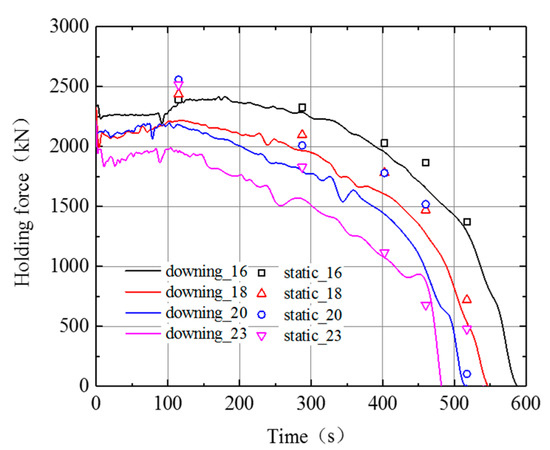
Figure 9.
Average of holding force under the two operation modes.
Next, the dominant frequency of holding force was analyzed for two operation modes. In fixed gate opening, the dominant frequency of holding force is 0.2 Hz and energy spectral frequency is mainly concentrated below 1 Hz. Nevertheless, vertical vibration frequency is mainly concentrated around 5–8 Hz. The frequency of holding force is inconsistent with the vertical vibration frequency and is close to the flow pulsation frequency yet. In closing process, the vertical vibration frequency and the frequency of holding force are consistent. The frequency decreases from 14 to 7 Hz gradually. Thus, the frequency between the holding force and vibration is not same for two operation modes. The difference may be attributed to the friction force caused by the gate motion state. In fixed gate opening, plane gate is in a state of static friction with the track. The direction of static friction force is changeable with the gate motion tendency. We tentatively put forward that, when the hydrodynamic loads are converted into the steel cable tension, static friction force with variable direction has a certain filtration effect on the loads. Only if the hydrodynamic loads are greater than the maximum static friction force can the loads be converted into the steel cable tension. Otherwise, the loads will be balanced through the static friction force. Thus, frequency of holding force is consistent with the flow pulsation frequency in fixed gate opening. Compared to the fixed gate opening, plane gate is in a state of sliding friction, and the friction force direction, opposite to the gate motion, is constant in closing process. Thus, the frequency of holding force is consistent with vertical vibration frequency in this case.
3.2.3. Crawl Vibration in Closing Process
In the closing process, the length of steel cable, water weight in gate lattice and water column on the gate top increase gradually. These changes directly reflect the increase of length L and mass m in Equation (3), which makes the nature frequency of the simplified system decrease. Besides, the flow boundary deformation and unsteady flow under the gate result in the variation of fluid inertia and make flow pulsation pressure acting on the gate bottom edge intensify significantly. Cai et al. [23] studied that the seismic waves had influenced on the maximum hydrodynamic pressure in curved gate. The results indicate that maximum hydrodynamic pressure of gate panel, considering the fluid–solid coupling effect, was 4–5 times higher than the theoretical value by the additional mass method. Thus, strong fluid–solid coupling effect could increase the hydrodynamic loads and crawl vibration appears in small gate opening. Ji et al. [32] regarded that the difference of dynamic and static friction coefficient was the main factor for crawl vibration. The necessary condition for the vibration is given as follows: Δμ × P/(v × ) > 1 (where Δμ is the difference of dynamic and static friction coefficient, P is the horizontal panel thrust, v is the closing gate speed, m is the gate mass and k is the transmission rod stiffness).
Table 3 provides the time parameters about the crawl vibration in the physical model test. With the upstream water depth increase, the gate-closing time decreases and duration of crawl vibration increases gradually. We regard that crawl vibration should be related to the upstream water depth and happen at specific external loads. When the gate structure and upstream water depth are determined, the horizontal panel thrust can be viewed as a control index for the crawl vibration. From the results in [32], horizontal panel thrust also played an important role in the crawl vibration. Once panel thrust exceeds the critical threshold, crawl vibration will appear. As upstream water depth increases, the time for panel thrust reaching the threshold decreases gradually so that initial crawl time decreases, as shown in Table 3.

Table 3.
The time parameters about the gate crawl vibration. Unit: s.
After the gate intermittent motion, the gate stopped moving at a certain distance from the chamber floor. The higher is the upstream water depth, the larger is the distance. The gate is not fully closed and the failure of gate-closing appears, which seriously threatens the operation of the projects. The failure has also happened in other physical model tests and engineering practices [33,34]. Because steel cable cannot provide the vertical downward loads, the gate can only utilize the self-weight, additional weight, water column on the gate top and water weight in the gate girder to close. Especially for the heavily sediment-carrying river, the sediment deposited in the gate slots exacerbates the above phenomenon [33]. Liang et al. [31] and Novak et al. [35] both suggested increasing gate speed can improve gate stability, avoid or delay the crawl vibration to a certain extent, which was good for the gate-closing.
To solve the above problem, increasing vertical downward loads by modified gate shape or additional mass is a common technical method. Ma et al. [34] proposed the method shown in Figure 10a. Placing a protruding boundary in front of the gate bottom edge and making full use of the water column could increase the vertical downward loads. Figure 10b provides the holding force for three body shapes in the physical model test. After the body modification, the holding force gradually increases, and gate can be completely closed. Besides, we should also focus on the concerned problems caused by body modification. In Figure 10b, when gate opening ratio e is 1–0.5 (gate-closing time is less than 250 s), the fluctuation value of holding force for three body shapes is relatively small. When gate opening ratio e is less than 0.5, the fluctuation value rapidly increases. The fluctuation value for the gate of leading edge with convex is roughly three times as much as the original body. The reason for this situation is that the gate of leading edge protrusion increases effective bottom width and leads to the separation and re-attachment of flow through the gate bottom intensified. It indicates the gate bottom width is direct factor for pressure fluctuation. Moreover, because hoists capacity converted by the prototype is about 500 N in the physical model test, the holding force has exceeded the maximum capacity for the modified gate of leading edge with convex. Fluctuation value of holding force goes back and forth to a large extent, which performs the axial deformation of steel cable and stress concentration in gate lug area. It is worth noting that stress concentration may result in tearing failure of lifting lug. Thus, the characteristics of holding force should be given more attention to prevent adverse problems in the actual operation of the modified gate.
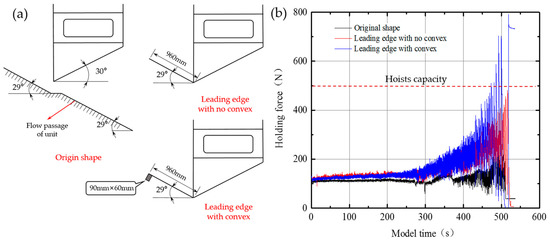
Figure 10.
Measures to make gate be closed completely in the physical model test: (a) original and modified shape of gate bottom edge [34]; and (b) holding force for three body shapes.
3.3. Correlation between Gate Vibration and Holding Force
Through the physical model test, we simultaneously measured the gate vibration and holding force. Gate vibrations in three directions are independent of each other. To explore the correlation between the gate vibration and holding force, we directly conducted the correlation and significance test between the two variables under two operation modes, respectively.
3.3.1. Correlation in Fixed Gate Opening
Table 4 shows the correlation and significance test between gate vibration and holding force in fixed gate opening. The distribution rule of correlation coefficient is not evident in three directions. Moreover, absolute value of correlation coefficient is relatively small and less than 0.3. It suggests that the correlation between gate vibration and holding force is weak. Thus, we can believe that gate vibration has no obvious impact on the holding force and its influence can be neglected for fixed gate opening.

Table 4.
Correlation between gate vibration and holding force in fixed gate opening.
3.3.2. Correlation in Closing Process
Table 5 describes the correlation and significance test between gate vibration and holding force in closing process. The results of significance test indicate a significant correlation between gate vibration and holding force. The correlation coefficient is different for different stages. To be specific, in the initial stage correlation coefficient in three directions is relatively small and the correlation is weak, indicating that gate vibration has a little influence on the holding force and can be ignored for calculating the hoists capacity. In the transitional stage, the average of correlation coefficient in lateral, vertical and horizontal direction is −0.565, 0.944 and −0.764, respectively. According to the correlation coefficient from large to small, they were ordered as: vertical > horizontal > lateral. Subsequently, in the crawl stage, the average of correlation coefficient in lateral, vertical and horizontal direction is −0.723, 0.733 and −0.664, respectively. The correlation coefficient from large to small was as follows: vertical > lateral > horizontal. Furthermore, in the transitional and crawl stage, holding force is positively correlated with the vertical vibration and is negatively correlated with the lateral and horizontal vibrations yet. It seems that gate motion state can account for the difference. In the transitional stage, the gate keeps falling and the vertical vibration is directly represented in the holding force. On the basis of the Newton’s second law, there is a liner relationship between gate vibration and holding force. Thus, the correlation is significantly positive, and its coefficient can reach 0.944. In the crawl stage, because the gate is in a state of intermittent motion, correlation coefficient is 0.733 and smaller than the transitional stage. Meanwhile, lateral and horizontal vibrations make the friction force originating from the seal pressure and panel thrust increase. Thus, the correlation coefficient is negative, and the vibration has a mitigating effect on the holding force. In contrast, if the gate is in an opening process, lateral and horizontal vibrations can increase the holding force and the correlation coefficient should be positive. In summary, the gate vibration effect on the holding force in closing process should be considered in determining the hoists capacity.

Table 5.
Correlation between gate vibration and holding force in closing process.
In addition, we concentrate only on the integral gate vibration as a rigid body in closing process. The limitation of this study is not to consider the horizontal deformation of gate itself in closing process. Anami et al. [36] replaced the circular-arc plate with a vertical, flat, rigid weir-plate and analyzed the rotational vibration along the weir-plate surface through the potential flow theory. The simplification of curved gate manifested that gate vibration was different at different gate heights in fixed gate opening. Yang et al. [29] also found vibration displacement at the bottom of plane gate was greater than at the middle in fixed gate opening. To facilitate the layout and not damage the structure of hydro-elastic gate, however, three acceleration sensors were installed near the gate lug in this study. Thus, the vibration near the lug might be unable to fully represent the characteristics of horizontal vibration. Nevertheless, the structure and operation mode between the curved gate and plane gate are both different. The reliability of the above results applied to a moving plane gate in this paper is uncertain. We have thus far not been able to quantity the uncertainty through the existing results. The following research will focus on the characteristics of horizontal vibration at different gate heights in closing process.
4. Conclusions
Physical model test was used to investigate the characteristics of gate vibration and holding force in a plane gate at two operation modes. More attention was paid to the gate vertical vibration and the correlation between the gate vibration and holding force. The results are as follows.
The vibration acceleration is significant in lateral and horizontal directions, and it is 10 times higher in the vertical direction in fixed gate opening. In closing process, however, vertical vibration is stronger than those in the lateral and horizontal directions. Dominant frequency of vertical vibration gradually decreases from 14 to 7 Hz in a step form. The experiment results also show that gate vertical vibration simplified into single degree of freedom is reasonable through equivalent stiffness theory.
At the same gate opening, the holding force in closing process is less than the fixed gate opening. The horizontal panel thrust of plane gate can be treated as a hydraulic factor for the crawl vibration. Once the panel thrust exceeds the critical threshold, crawl vibration happens. After the crawl vibration, the gate stops motion at a certain distance from the chamber floor and the failure of gate-closing happens. The higher is the upstream water level, the greater is the distance. Increasing the vertical downward loads by modified shape of gate bottom edge can solve the failure of gate closing. More attention should be paid to the holding force to prevent the large fluctuation value from exceeding hoists capacity and tearing failure.
For fixed gate opening, gate vibration has almost no influence on holding force and can be ignored in determining the hoists capacity. In closing process, however, absolute value of correlation coefficient in three directions is relatively high. Holding force is significantly positively correlated with the vertical vibration and is significantly negatively correlated with lateral and horizontal vibrations. Thus, the gate vibration effect on the holding force should be considered in determining the hoists capacity under closing process.
Author Contributions
Conceptualization, Y.W. and G.X.; methodology, Y.W. and G.X.; investigation, Y.W.; data curation, W.L.; writing—original draft preparation, W.L.; writing—review and editing, F.L. and Y.D.; visualization, Y.W.; and supervision, G.X. All authors have read and agreed to the published version of the manuscript.
Funding
This research was funded by National Natural Science Foundation of China (Grant No. 51779166).
Acknowledgments
The authors gratefully acknowledge the editors and anonymous reviewers for their insightful and professional comments, which greatly improved this manuscript.
Conflicts of Interest
The authors declare no conflict of interest.
References
- Darbre, G.R.; Smet, C.A.M.D.; Kraemer, C. Natural frequencies measured from ambient vibration response of the arch dam of Mauvoisin. Earthq. Eng. Struct. D. 2015, 29, 577–586. [Google Scholar] [CrossRef]
- Wójcicki, Z.; Kostecki, S.; Grosel, J. Operational Modal Analysis of Weir on Odra River in Poland. Procedia Eng. 2016, 153, 874–881. [Google Scholar] [CrossRef][Green Version]
- Peng, Y.; Zhang, J.; Xu, W.-L.; Rubinato, M. Experimental Optimization of Gate-Opening Modes to Minimize Near-Field Vibrations in Hydropower Stations. Water 2018, 10, 1435. [Google Scholar] [CrossRef]
- Lian, J.; Zheng, Y.; Liang, C.; Ma, B. Analysis for the Vibration Mechanism of the Spillway Guide Wall Considering the Associated-Forced Coupled Vibration. Appl. Sci. 2019, 9, 2572. [Google Scholar] [CrossRef]
- Hardwick, J.D. Flow-induced vibration of vertical-lift gate. J. Hydraul. Div. ASCE. 1974, 1005, 631–644. [Google Scholar]
- Jongeling, T.H.G. Flow-induced self-excited in-flow vibrations of gate plates. J. Fluids Struct. 1988, 2, 541–566. [Google Scholar] [CrossRef]
- Naudascher, E. Flow-induced loading and vibration of gates. Proc. Int. Symp. Hydraul. High Dams 1988, 1–18. [Google Scholar]
- Thang, N.D.; Naudascher, E. Self-excited vibrations of vertical-lift gate. J. Hydraul. Res. 1986, 24, 391–404. [Google Scholar] [CrossRef]
- Thang, N.D. Gate Vibrations due to Unstable Flow Separation. J. Hydraul. Eng. 1990, 116, 342–361. [Google Scholar] [CrossRef]
- Ishii, N.; Knisely, C.W. Flow-induced vibration of shell-type long-span gates. J. Fluids Struct. 1992, 6, 681–703. [Google Scholar] [CrossRef]
- Ishii, N.; Knisely, C.W.; Nakata, A. Coupled-Mode Vibration of Gates with Simultaneous Over-and Underflow. J. Fluids Struct. 1994, 8, 455–469. [Google Scholar] [CrossRef]
- Ogihara, K.; Ueda, S. The Conditions of Self-Excited Vibration Occurring in Radial Gates. Water Power Conf. 1999, 1–10. [Google Scholar] [CrossRef]
- Chowdhury, M.R.; Hall, R.L. Dynamic Performance Evaluation of Gate Vibration. J. Struct. Eng. 1999, 125, 445–452. [Google Scholar] [CrossRef]
- Anami, K.; Ishii, N.; Knisely, C.W.; Tsuji, T.; Oku, T.; Sato, S. Friction-Maintained Dynamic Stability. In Vibration Problems ICOVP 2011. Springer Proc. Phys. 2011, 779–785. [Google Scholar] [CrossRef]
- Kolkman, P.A.; Vrijer, A. Vertical Gate Vibrations by Galloping or By Fluid Inertia. J. Hydraul. Res. 1987, 25, 418–423. [Google Scholar] [CrossRef]
- Markovic, J.; Drobir, H. A high head gate innovation numerical and experiment analysis of hydrodynamic forces. Math. Model. Civ. Eng. 2010, 2, 27–34. [Google Scholar]
- Erdbrink, C.D.; Krzhizhanovskaya, V.V.; Sloot, P. Reducing cross-flow vibrations of underflow gates: Experiments and numerical studies. J. Fluids Struct. 2014, 50, 25–48. [Google Scholar] [CrossRef]
- Lee, S.O.; Seong, H.; Kang, J.W. Flow-induced vibration of a radial gate at various opening heights. Eng. Appl. Comput. Fluid Mech. 2018, 12, 567–583. [Google Scholar] [CrossRef]
- Demirel, E.; Aral, M.M. A Design for Vortex Suppression Downstream of a Submerged Gate. Water 2020, 12, 750. [Google Scholar] [CrossRef]
- Gao, Z.; Yan, G.; Liu, P.; Chen, F.; Lv, F. Study on Flow-Induced Vibration Characteristics of Hydraulic Hoist of large-Span up welling Radial Steel Gate. Appl. Mech. Mater. 2011, 117, 241–246. [Google Scholar]
- Ng, F.C.; Abas, A.; Abustan, I.; Rozainy, Z.M.R.; Abdullah, M.; Jamaludin, A.b.; Kon, S.M. Fluid/structure interaction study on the variation of radial gate’s gap height in dam. IOP Conf. Ser. Mater. Sci. Eng. 2018, 370, 012063. [Google Scholar] [CrossRef]
- Shen, C.; Wang, W.; He, S.; Xu, Y. Numerical and Experimental Comparative Study on the Flow-Induced Vibration of a Plane Gate. Water 2018, 10, 1551. [Google Scholar] [CrossRef]
- Cai, Y.F.; Han, Y.F. Research on the Radial Gate Fluid-Structure Coupling of Hydraulic Steel Gate. Appl. Mech. Mater. 2015, 733, 468–471. [Google Scholar] [CrossRef]
- Lian, J.J.; Chen, L.; Liang, C.; Liu, F. Presentation and Verification of an Optimal Operating Scheme Aiming at Reducing the Ground Vibration Induced by High Dam Flood Discharge. Int. J. Environ. Res. Public Health 2020, 17, 377. [Google Scholar] [CrossRef] [PubMed]
- Lian, J.J.; Chen, L.; Ma, B.; Liang, C. Analysis of the Cause and Mechanism of Hydraulic Gate Vibration during Flood Discharging from the Perspective of Structural Dynamics. Appl. Sci. 2020, 10, 629. [Google Scholar] [CrossRef]
- Yang, M.; Lian, J.J.; Lin, J.Y. Excitation mechanism of flow induced plane gate vibration. J. Hydrodyn. 1997, 4, 437–449. (In Chinese) [Google Scholar]
- Billeter, P.; Staubli, T. Flow-induced multiple-mode vibrations of gates with submerged discharge. J. Fluids Struct. 2000, 14, 323–338. [Google Scholar] [CrossRef]
- Yan, G.H.; Chen, J.F. Prototype observation and study on flow induced vibration of curved gate in surface hole of spillway dam. J. Hydroelectr. Eng. 2012, 2, 142–147. (In Chinese) [Google Scholar]
- Yang, T.; He, S.; Shen, C.; Yang, Q. Fluid-induced Vibrations Test of Hydraulic Plane Gate for Different Conditions. Int. Conf. Sens. 2016, 1083–1089. [Google Scholar] [CrossRef]
- Ministry of Water Resources of the People’s Republic of China. Specification for Design of Steel Gate in Hydraulic and Hydroelectric Engineering (NB 35055—2015); China Water & Power Press: Beijing, China, 2015; pp. 52–54. (In Chinese)
- Liang, C.; Zhang, J.L.; Lian, J.J.; Liu, F. Research on slip-stick vibration of emergency gate induced by high dam flood discharge. J. Hydraul. Eng. 2018, 49, 1503–1511, 1522. (In Chinese) [Google Scholar]
- Ji, S.K.; Zhou, L. Vibration analysis of sluice gate closure process for diversion of Yellow River. Water Conserv. Hydropower Technol. 2001, 12, 64–66. (In Chinese) [Google Scholar]
- Li, G.Q.; Yang, J.W.; Yang, B.; Li, B. Analysis of prototype observation results of lifting and closing force of sluice gate in spillway tunnel of tianqiao hydropower station. Water Conserv. Hydropower Technol. 2005, 10, 4–7. (In Chinese) [Google Scholar]
- Ma, C.; Sheng, C.; Lian, J.; Ma, B.; Liu, F. Failure analysis of a leaf gate jammed in closing process. Eng. Fail. Anal. 2020, 110, 104391. [Google Scholar] [CrossRef]
- Novak, G.; Mlateralčnik, J.; Bombač, M.; Vošnjak, S. Hydrodynamic forces during the operation of a model radial gate. J. Appl. Water Eng. Res. 2016, 51, 70–77. [Google Scholar] [CrossRef]
- Anami, K.; Ishii, N.; Knisely, C.W. Pressure induced by vertical planar and inclined curved weir-plates undergoing streamwise rotational vibration. J. Fluids Struct. 2012, 29, 35–49. [Google Scholar] [CrossRef]
© 2020 by the authors. Licensee MDPI, Basel, Switzerland. This article is an open access article distributed under the terms and conditions of the Creative Commons Attribution (CC BY) license (http://creativecommons.org/licenses/by/4.0/).